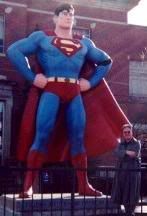| Pop Culture Gadabout | ||
|
Friday, April 11, 2003 ( 4/11/2003 08:53:00 AM ) Bill S. “MAMA SAID THERE’D BE . . .” – The three high-schoolers who comprise Tina and the Tiaras exemplify an era of 60’s pop singers: girl groups who typically went by names like the Chiffons or Chantels, Shangri-Las or Supremes. The sound of pre-feminist teengirls singing somebody else’s hopes and dreams – it’s a moment in pop history that’s neatly captured in J. Torres & Scott Chantler’s charm-packed graphic novel Days Like This (Oni Press). Set in the early 60’s (we see one character, a songwriter named Karen Prince – the name recalls Carole King, but there’s also a trace of Wonder Woman in it – looking for Suites 1958–1964 in the Brill-like Harmony Plaza), the book charts the early days of the Tiaras, the young teenaged songwriter who’ll compose their hits and the neophyte woman record mogul who discovers the group. Primary focus is on lead singer Christina, a fourteen-year girl who we first meet singing along to a 45 in preparation for a high school talent show. As with mentor Anna Solomon, Tina has to contend with male scorn and resistance toward her talents. In the case of the girl singer, this opposition comes from her hard-working father Luther, who couples wounded pride with an honest Christian fear that his daughter will be corrupted by this rock ‘n’ roll world. (“Have you heard about this Little Richard character?” he demands at one point. “The man who wears makeup? Only man I know wears makeup is a clown!”) In Anna’s case, it’s from the disdainful reaction of her peers in the music business. Starting her own record label with the money she’s gotten in a divorce settlement from her ex-husband Abe, Anna is disparagingly called a “housewife” by her wormy former brother-in-law Ben. “How things would be different if we housewives ran the country,” she says at one point to Tina’s supportive mother. Days (the title is taken from a Shirelles hit – as are the chapter headings) excels at capturing the feel of its era: artist Scott Chantler is especially adept at conveying the styles of the day, while his concise black-and-white ink work also conveys the period feel. Scripter Torres’ main interest is in capturing the first steps of artist confidence. Unlike most traditional show biz stories, we don’t see the artists’ decline, just the moments of naive enthusiasm and joy at discovering your own voice. As delightful as many of the book’s characters are, they remain secondary to the book’s foremost concern: the nascent awareness that sisters can do it for themselves. There aren’t a lot of comic books devoted to oldies-but-goodies rock ‘n’ roll, let alone an era that's frequently marginalized for its pop lightness. If I have any complaint about Days, it lies in my wish that we’d gotten at least one good look inside the recording process (we primarily learn about it second-hand as Tina describes it to her younger brother); more panels are devoted to the Tiaras trying on matching dresses than to actually making their first hit record. But that’s just the pop lover in me grousing. Taken on its own sparkling terms, Days Like This reminds us of this one incontrovertible pop culture truism: that even something as seemingly lightweight and inconsequential as a teen-beat single can be a major breakthrough for those who created it. # | |
|
|

